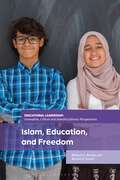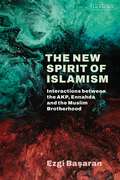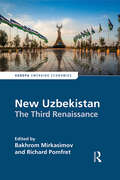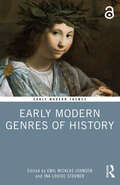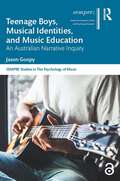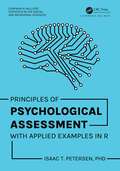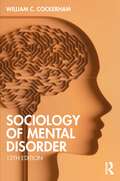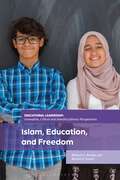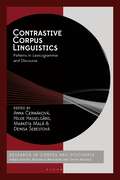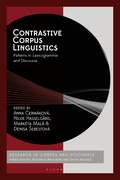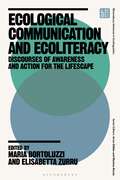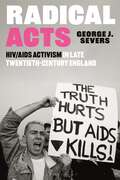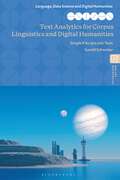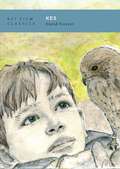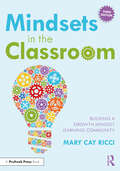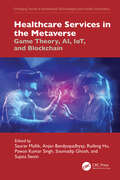- Table View
- List View
Islam, Education, and Freedom: An Uncommon Perspective on Leadership (Educational Leadership: Innovative, Critical and Interdisciplinary Perspectives)
by Melanie C. Brooks Dr Miriam D. EzzaniIslam, Education and Freedom explores six key areas of freedom: identity, acceptance, pedagogy, conflict, trust, and love. Based on a qualitative case study of a progressive Islamic school in Southern California, North Star Academy, the book illustrates through the voices of the participants how each particular freedom was applied in the school. The authors show how the six freedoms were understood, taught, and practiced with the aim of developing courageous and confident American Muslims. It explores the ways the school leaders facilitate and impart each freedom and the influence this has on the development of American Muslim students' identity.The book culminates with a model for freedom in Islamic schooling. It concludes with three key insights: (1) Islamic schooling can facilitate or constrain the way that leaders, teachers, students, and the school community experience freedom; (2) as freedom is a core value of Islam, it should be made central to the conceptualization and practice of Islamic schooling; and, (3) Islamic schooling, when grounded in the six freedoms, can be a pathway to comprehensive school reform and is applicable to Islamic schools. The book includes a Foreword written by Khaula Murtadha, Associate Vice Chancellor for the Office of Community Engagement, Indiana University–Purdue University Indianapolis, USA.
The New Spirit of Islamism: Interactions between the AKP, Ennahda and the Muslim Brotherhood
by Ezgi BasaranThis book explains the aspirations and concerns of Islamist actors in the aftermath of the Arab Uprisings by looking at two sets of relationships between Turkey's ruling AKP and the Egyptian Muslim Brotherhood, and the AKP and Tunisia's Ennahda. It presents a unique analysis of the interplay between the AKP, Ennahda and the Muslim Brotherhood, characterizing the actors, the structure and the main features of the relationship and thereby illuminating a political confluence among these three critical Islamist entities in the aftermath of the Arab Uprisings. Existing scholarship has assumed that this relationship revolves primarily around an ideological Islamist agenda, however, this research demonstrates a more complex and nuanced situation. Ezgi Basaran puts forward that the interplay was not based on an aspiration of building an ideological Islamist bloc in the MENA region, but rather revolved around the concept of political success and had a strong neoliberal ethos. Basaran draws on data collected from over 60 interviews with high-level members of the AKP, Ennahda and Muslim Brotherhood to demonstrate how, in the hope of achieving success and legitimization, Ennahda and the Muslim Brotherhood have relied on the managerial prescriptions provided by the AKP. The contents of this success formula were derived from the AKP's experience as an Islamist party in power since 2002 and includes tactics on crisis evasion, legitimization, winning elections and maintaining power.
New Uzbekistan: The Third Renaissance (Europa Perspectives: Emerging Economies)
by Bakhrom Mirkasimov Richard PomfretThis book reviews and analyses the comprehensive socioeconomic reforms undertaken in Uzbekistan since 2016 by the government led by President Shavkat Mirziyoyev. The volume takes the reader through the different sectors of the economy and the effects of reforms on the country’s citizens. The various developments are detailed, examining the gains and the gaps in terms of policy and implementation. Using the broad tools of economics and, in particular, of development economics, the authors present evidence to drive their conclusions and recommendations, and also draw on comparative cases from policy and practice to illustrate alternative approaches and results from measures in other transition countries.Implementing Uzbekistan’s ambitious economic transformation into a market economy is a challenging process that takes time. This book provides the first systematic and comprehensive discussion of the government’s reform areas, including the macroeconomic fundamentals, business and investment climate, the energy, transport, health, education, social protection, financial, banking and agriculture sectors, regional trade, tourism and transport connectivity, reform of state-owned enterprises, as well as public services, citizen engagement and gender equality.
New Uzbekistan: The Third Renaissance (Europa Perspectives: Emerging Economies)
by Bakhrom Mirkasimov Richard PomfretThis book reviews and analyses the comprehensive socioeconomic reforms undertaken in Uzbekistan since 2016 by the government led by President Shavkat Mirziyoyev. The volume takes the reader through the different sectors of the economy and the effects of reforms on the country’s citizens. The various developments are detailed, examining the gains and the gaps in terms of policy and implementation. Using the broad tools of economics and, in particular, of development economics, the authors present evidence to drive their conclusions and recommendations, and also draw on comparative cases from policy and practice to illustrate alternative approaches and results from measures in other transition countries.Implementing Uzbekistan’s ambitious economic transformation into a market economy is a challenging process that takes time. This book provides the first systematic and comprehensive discussion of the government’s reform areas, including the macroeconomic fundamentals, business and investment climate, the energy, transport, health, education, social protection, financial, banking and agriculture sectors, regional trade, tourism and transport connectivity, reform of state-owned enterprises, as well as public services, citizen engagement and gender equality.
Early Modern Genres of History (Early Modern Themes)
by Emil Nicklas Johnsen Ina Louise StovnerBringing together an international group of literary scholars, intellectual historians, and cultural historians, this book discusses history in its various forms, either as texts or images in the early modern period (1500–1800).Early Modern Genres of History explores different genres and representational modes regarded as history before history became a scientific discipline during the nineteenth century. It does not seek to show how the modern discipline of history as an academic study developed, but rather to examine the ways in which historical texts and images became part of a wider field of early modern knowledge formations. This volume demonstrates how history was connected to the developments in the public sphere, how antiquarian historians used genres in their work, how history evolved and functioned in the visual field, and how historical genres travelled across different contexts. Overall, Early Modern Genres of History reveals how the diversity of historical representations in the early modern period has contributed to the broader foundations of history as it is understood in the twenty-first century.This volume is of great use to upper-level undergraduates, postgraduates, and scholars interested in early modern Europe and the history of knowledge across both the history and literature disciplines.
Teenage Boys, Musical Identities, and Music Education: An Australian Narrative Inquiry (ISSN)
by Jason GoopyMusic is a powerful process and resource that can shape and support who we are and wish to be. The interaction between musical identities and learning music highlights school music education’s potential contributions and responsibilities, especially in supporting young people’s mental health and well-being. Through the distinctive stories and drawings of Aaron, Blake, Conor, Elijah, Michael, and Tyler, this book reveals the musical identities of teenage boys in their final year of study at an Australian boys’ school.This text serves as an interface between music, education, and psychology using narrative inquiry. Previous research in music education often seeks to generalise boys, whereas this study recognises and celebrates the diverse individual voices of students where music plays a significant role in their lives. Adolescent boys’ musical identities are examined using the theories of identity work and possible selves, and their underlying music values and uses are considered important guiding principles and motivating goals in their identity construction. A teaching and learning framework to shape and support multiple musical identities in senior secondary class music is presented.The relatable and personal stories in this book will appeal to a broad readership, including music teachers, teacher educators, researchers, and readers interested in the role of music in our lives. Creative and arts-based research methods, including narrative inquiry and innovative draw and tell interviews, will be particularly relevant for research method courses and postgraduate research students.
Early Modern Genres of History (Early Modern Themes)
Bringing together an international group of literary scholars, intellectual historians, and cultural historians, this book discusses history in its various forms, either as texts or images in the early modern period (1500–1800).Early Modern Genres of History explores different genres and representational modes regarded as history before history became a scientific discipline during the nineteenth century. It does not seek to show how the modern discipline of history as an academic study developed, but rather to examine the ways in which historical texts and images became part of a wider field of early modern knowledge formations. This volume demonstrates how history was connected to the developments in the public sphere, how antiquarian historians used genres in their work, how history evolved and functioned in the visual field, and how historical genres travelled across different contexts. Overall, Early Modern Genres of History reveals how the diversity of historical representations in the early modern period has contributed to the broader foundations of history as it is understood in the twenty-first century.This volume is of great use to upper-level undergraduates, postgraduates, and scholars interested in early modern Europe and the history of knowledge across both the history and literature disciplines.
Teenage Boys, Musical Identities, and Music Education: An Australian Narrative Inquiry (ISSN)
by Jason GoopyMusic is a powerful process and resource that can shape and support who we are and wish to be. The interaction between musical identities and learning music highlights school music education’s potential contributions and responsibilities, especially in supporting young people’s mental health and well-being. Through the distinctive stories and drawings of Aaron, Blake, Conor, Elijah, Michael, and Tyler, this book reveals the musical identities of teenage boys in their final year of study at an Australian boys’ school.This text serves as an interface between music, education, and psychology using narrative inquiry. Previous research in music education often seeks to generalise boys, whereas this study recognises and celebrates the diverse individual voices of students where music plays a significant role in their lives. Adolescent boys’ musical identities are examined using the theories of identity work and possible selves, and their underlying music values and uses are considered important guiding principles and motivating goals in their identity construction. A teaching and learning framework to shape and support multiple musical identities in senior secondary class music is presented.The relatable and personal stories in this book will appeal to a broad readership, including music teachers, teacher educators, researchers, and readers interested in the role of music in our lives. Creative and arts-based research methods, including narrative inquiry and innovative draw and tell interviews, will be particularly relevant for research method courses and postgraduate research students.
Principles of Psychological Assessment: With Applied Examples in R (Chapman & Hall/CRC Statistics in the Social and Behavioral Sciences)
by Isaac T. PetersenThis book highlights the principles of psychological assessment to help researchers and clinicians better develop, evaluate, administer, score, integrate, and interpret psychological assessments. It discusses psychometrics (reliability and validity), the assessment of various psychological domains (behavior, personality, intellectual functioning), various measurement methods (e.g., questionnaires, observations, interviews, biopsychological assessments, performance-based assessments), and emerging analytical frameworks to evaluate and improve assessment including: generalizability theory, structural equation modeling, item response theory, and signal detection theory. The text also discusses ethics, test bias, and cultural and individual diversity.Key Features Gives analysis examples using free software Helps readers apply principles to research and practice Provides text, analysis code/syntax, R output, figures, and interpretations integrated to guide readers Uses the freely available petersenlab package for R Principles of Psychological Assessment: With Applied Examples in R is intended for use by graduate students, faculty, researchers, and practicing psychologists.
Principles of Psychological Assessment: With Applied Examples in R (Chapman & Hall/CRC Statistics in the Social and Behavioral Sciences)
by Isaac T. PetersenThis book highlights the principles of psychological assessment to help researchers and clinicians better develop, evaluate, administer, score, integrate, and interpret psychological assessments. It discusses psychometrics (reliability and validity), the assessment of various psychological domains (behavior, personality, intellectual functioning), various measurement methods (e.g., questionnaires, observations, interviews, biopsychological assessments, performance-based assessments), and emerging analytical frameworks to evaluate and improve assessment including: generalizability theory, structural equation modeling, item response theory, and signal detection theory. The text also discusses ethics, test bias, and cultural and individual diversity.Key Features Gives analysis examples using free software Helps readers apply principles to research and practice Provides text, analysis code/syntax, R output, figures, and interpretations integrated to guide readers Uses the freely available petersenlab package for R Principles of Psychological Assessment: With Applied Examples in R is intended for use by graduate students, faculty, researchers, and practicing psychologists.
Sociology of Mental Disorder
by William C. CockerhamThe twelfth edition of the Sociology of Mental Disorder presents the major issues and research findings on the influence of race, social class, gender, and age on the incidence and prevalence of mental disorders. The text also examines the institutions that help those with mental disorders, mental health law, and public policy. Many important updates are new to this edition: The mental health effects of the COVID-19 pandemic are examined. Aging and mental health is discussed in more detail. Updated review of gender differences in mental disorder. A revised and more in-depth discussion of mental health and race. Problems in the community care of the mentally ill are covered. Updates of research and citations throughout. Blending foundational concepts and sociological perspectives on mental health issues with newer studies and accounts in an accessible and authoritative survey of the field, the new edition of Sociology of Mental Disorder remains an essential text and an invaluable resource for students and scholars.
Sociology of Mental Disorder
by William C. CockerhamThe twelfth edition of the Sociology of Mental Disorder presents the major issues and research findings on the influence of race, social class, gender, and age on the incidence and prevalence of mental disorders. The text also examines the institutions that help those with mental disorders, mental health law, and public policy. Many important updates are new to this edition: The mental health effects of the COVID-19 pandemic are examined. Aging and mental health is discussed in more detail. Updated review of gender differences in mental disorder. A revised and more in-depth discussion of mental health and race. Problems in the community care of the mentally ill are covered. Updates of research and citations throughout. Blending foundational concepts and sociological perspectives on mental health issues with newer studies and accounts in an accessible and authoritative survey of the field, the new edition of Sociology of Mental Disorder remains an essential text and an invaluable resource for students and scholars.
Islam, Education, and Freedom: An Uncommon Perspective on Leadership (Educational Leadership: Innovative, Critical and Interdisciplinary Perspectives)
by Melanie C. Brooks Dr Miriam D. EzzaniIslam, Education and Freedom explores six key areas of freedom: identity, acceptance, pedagogy, conflict, trust, and love. Based on a qualitative case study of a progressive Islamic school in Southern California, North Star Academy, the book illustrates through the voices of the participants how each particular freedom was applied in the school. The authors show how the six freedoms were understood, taught, and practiced with the aim of developing courageous and confident American Muslims. It explores the ways the school leaders facilitate and impart each freedom and the influence this has on the development of American Muslim students' identity.The book culminates with a model for freedom in Islamic schooling. It concludes with three key insights: (1) Islamic schooling can facilitate or constrain the way that leaders, teachers, students, and the school community experience freedom; (2) as freedom is a core value of Islam, it should be made central to the conceptualization and practice of Islamic schooling; and, (3) Islamic schooling, when grounded in the six freedoms, can be a pathway to comprehensive school reform and is applicable to Islamic schools. The book includes a Foreword written by Khaula Murtadha, Associate Vice Chancellor for the Office of Community Engagement, Indiana University–Purdue University Indianapolis, USA.
Contrastive Corpus Linguistics: Patterns in Lexicogrammar and Discourse (Corpus and Discourse)
Marking 30 years of contrastive corpus linguistics, this volume provides a state-of-the-art of the field, charting its development over time and expanding the boundaries of the discipline. Focusing on a diversity of methods and approaches to language comparison, it uses both comparable and translation corpora, and explores a broad range of language registers from newspaper reporting and spoken political discourse to film scripts and football match reports. Using English as the pivot language for each chapter, the volume offers contrastive bilingual and trilingual perspectives on a number of languages, including Czech, Finnish, French, German, Norwegian, Spanish, and Swedish, covering a typologically diverse field. By exploring the application of complex multi-genre multilingual data sets and expanding the horizons of contrastive studies, it demonstrates how a juxtaposition of cross-linguistic and register variation can deepen our insight into language variation and use.The volume is dedicated to two prominent contrastive corpus linguists: Karin Aijmer and Bengt Altenberg, who have decisively shaped the discipline from its very beginnings. The book opens with a chapter by Aijmer, reflecting on the current breadth and future prospects of research in the area while pointing to emergent trends with an insight that only she can offer.
Contrastive Corpus Linguistics: Patterns in Lexicogrammar and Discourse (Corpus and Discourse)
by Anna Cermakova, Hilde Hasselgård, Markéta Malá and Denisa ŠebestováMarking 30 years of contrastive corpus linguistics, this volume provides a state-of-the-art of the field, charting its development over time and expanding the boundaries of the discipline. Focusing on a diversity of methods and approaches to language comparison, it uses both comparable and translation corpora, and explores a broad range of language registers from newspaper reporting and spoken political discourse to film scripts and football match reports. Using English as the pivot language for each chapter, the volume offers contrastive bilingual and trilingual perspectives on a number of languages, including Czech, Finnish, French, German, Norwegian, Spanish, and Swedish, covering a typologically diverse field. By exploring the application of complex multi-genre multilingual data sets and expanding the horizons of contrastive studies, it demonstrates how a juxtaposition of cross-linguistic and register variation can deepen our insight into language variation and use.The volume is dedicated to two prominent contrastive corpus linguists: Karin Aijmer and Bengt Altenberg, who have decisively shaped the discipline from its very beginnings. The book opens with a chapter by Aijmer, reflecting on the current breadth and future prospects of research in the area while pointing to emergent trends with an insight that only she can offer.
Ecological Communication and Ecoliteracy: Discourses of Awareness and Action for the Lifescape (Bloomsbury Advances in Ecolinguistics)
by Maria Bortoluzzi and Elisabetta ZurruThis open access volume is a call for ecological awareness and action through communication. It offers perspectives on how we, as humans, posit ourselves in relation to, and as part of, the environment in both verbal and non-verbal discourse. The contributions investigate a variety of situated communicative practices and how they instantiate and potentially influence our actions. Through the frameworks of ecolinguistics, multimodal studies and ecoliteracy, the book discusses how the environmental crisis is communicated as an urgent global and local issue in a variety of media, texts and events. The contributions present a wide range of case studies (including news articles, institutional websites, artwork installations, promotional texts, signposting, social campaigns and other), and they explore how communicative actions can help meet the challenges of ecologically-oriented change. The focus is on the impact that linguistic and multimodal communication can have on acting in, with and towards the environment seen as living ecosystems, or 'lifescapes'. The chapters offer a reflection on the way we experience, endorse, reframe and resist value systems in ecological communication, and propose alternative and healthier perspectives to respect and preserve the common and nurturing lifescapes through awareness and action.The ebook editions of this book are available open access under a CC BY-NC-ND 4.0 licence on bloomsburycollections.com.
Ecological Communication and Ecoliteracy: Discourses of Awareness and Action for the Lifescape (Bloomsbury Advances in Ecolinguistics)
This open access volume is a call for ecological awareness and action through communication. It offers perspectives on how we, as humans, posit ourselves in relation to, and as part of, the environment in both verbal and non-verbal discourse. The contributions investigate a variety of situated communicative practices and how they instantiate and potentially influence our actions. Through the frameworks of ecolinguistics, multimodal studies and ecoliteracy, the book discusses how the environmental crisis is communicated as an urgent global and local issue in a variety of media, texts and events. The contributions present a wide range of case studies (including news articles, institutional websites, artwork installations, promotional texts, signposting, social campaigns and other), and they explore how communicative actions can help meet the challenges of ecologically-oriented change. The focus is on the impact that linguistic and multimodal communication can have on acting in, with and towards the environment seen as living ecosystems, or 'lifescapes'. The chapters offer a reflection on the way we experience, endorse, reframe and resist value systems in ecological communication, and propose alternative and healthier perspectives to respect and preserve the common and nurturing lifescapes through awareness and action.The ebook editions of this book are available open access under a CC BY-NC-ND 4.0 licence on bloomsburycollections.com.
Radical Acts: HIV/AIDS Activism in Late Twentieth-Century England
by George SeversDrawing on activist campaign literature and materials, broadcast media, and new oral history interviews, Severs reconstructs and discusses the overlooked world of radical AIDS activism in England. This book provides one of the first detailed histories of the radical HIV/AIDS movement in England, following ACT UP's travels from New York to London via prominent queer intellectuals, and reconstructing the vibrant theatrical campaigns staged by ACT UP groups across England. Radical Acts explores expressions of activism that were far more common than demonstrations and marches. Manifestations of a political commitment to ameliorating the injustices facing people living with HIV permeated most aspects of everyday life. These forms of 'everyday activism' played out in workplaces, universities and church halls across England, as well as through networks that stretched across Europe and North America. This book breaks new ground by studying the radical alongside the everyday, presenting a diverse constellation of activist responses to the epidemic.
Radical Acts: HIV/AIDS Activism in Late Twentieth-Century England
by George SeversDrawing on activist campaign literature and materials, broadcast media, and new oral history interviews, Severs reconstructs and discusses the overlooked world of radical AIDS activism in England. This book provides one of the first detailed histories of the radical HIV/AIDS movement in England, following ACT UP's travels from New York to London via prominent queer intellectuals, and reconstructing the vibrant theatrical campaigns staged by ACT UP groups across England. Radical Acts explores expressions of activism that were far more common than demonstrations and marches. Manifestations of a political commitment to ameliorating the injustices facing people living with HIV permeated most aspects of everyday life. These forms of 'everyday activism' played out in workplaces, universities and church halls across England, as well as through networks that stretched across Europe and North America. This book breaks new ground by studying the radical alongside the everyday, presenting a diverse constellation of activist responses to the epidemic.
Text Analytics for Corpus Linguistics and Digital Humanities: Simple R Scripts and Tools (Language, Data Science and Digital Humanities)
by Gerold SchneiderDo you want to gain a deeper understanding of how big tech analyzes and exploits our text data, or investigate how political parties differ by analyzing textual styles, associations and trends in documents? Or create a map of a text collection and write a simple QA system yourself? This open access book explores how to apply state-of-the-art text analytics methods to detect and visualize phenomena in text data. Solidly based on methods from corpus linguistics, natural language processing, text analytics and digital humanities, this book shows readers how to conduct experiments with their own corpora and research questions, underpin their theories, quantify the differences and pinpoint characteristics. Case studies and experiments are detailed in every chapter using real-world and open access corpora from politics, World English, history, and literature. The results are interpreted and put into perspective, pitfalls are pointed out, and necessary pre-processing steps are demonstrated. This book also demonstrates how to use the programming language R, as well as simple alternatives and additions to R, to conduct experiments and employ visualisations by example, with extensible R-code, recipes, links to corpora, and a wide range of methods. The methods introduced can be used across texts of all disciplines, from history or literature to party manifestos and patient reports.The ebook editions of this book are available open access under a CC BY-NC-ND 4.0 licence on bloomsburycollections.com.
Text Analytics for Corpus Linguistics and Digital Humanities: Simple R Scripts and Tools (Language, Data Science and Digital Humanities)
by Gerold SchneiderDo you want to gain a deeper understanding of how big tech analyzes and exploits our text data, or investigate how political parties differ by analyzing textual styles, associations and trends in documents? Or create a map of a text collection and write a simple QA system yourself? This open access book explores how to apply state-of-the-art text analytics methods to detect and visualize phenomena in text data. Solidly based on methods from corpus linguistics, natural language processing, text analytics and digital humanities, this book shows readers how to conduct experiments with their own corpora and research questions, underpin their theories, quantify the differences and pinpoint characteristics. Case studies and experiments are detailed in every chapter using real-world and open access corpora from politics, World English, history, and literature. The results are interpreted and put into perspective, pitfalls are pointed out, and necessary pre-processing steps are demonstrated. This book also demonstrates how to use the programming language R, as well as simple alternatives and additions to R, to conduct experiments and employ visualisations by example, with extensible R-code, recipes, links to corpora, and a wide range of methods. The methods introduced can be used across texts of all disciplines, from history or literature to party manifestos and patient reports.The ebook editions of this book are available open access under a CC BY-NC-ND 4.0 licence on bloomsburycollections.com.
Kes (BFI Film Classics)
by David ForrestKen Loach's 1969 drama Kes, considered one of the finest examples of British social realism, tells the story of Billy, a working class boy who finds escape and meaning when he takes a fledgling kestrel from its nest.David Forrest's study of the film examines the genesis of the original novel, Barry Hines' A Kestrel for a Knave (1968), the eventual collaboration that brought it to the screen, and the film's funding and production processes. He provides an in depth analysis of key scenes and draws on archival sources to shed new light on the film's most celebrated moments. He goes on to consider the film's lasting legacy, having influenced films like Ratcatcher (1999) and This is England (2006), both in terms of its contribution to film history and as a document of political and cultural value. He makes a case for the film's renewed relevance in our present era of systemic economic (and regional) inequality, alienated labour, increasingly narrow educational systems, toxic masculinity, and ecological crisis. Kes endures, he argues, because it points towards the possibility for emancipation and fulfilment through a more responsive and nurturing approach to education, a more delicate and symbiotic relationship with landscape and the non-human, and an emotional articulacy and sensitivity shorn of the rigid expectations of gender.
Mindsets in the Classroom: Building a Growth Mindset Learning Community
by Mary Cay RicciThe latest edition of Mindsets in the Classroom provides educators with ideas and strategies to build a growth mindset school culture, wherein students are challenged to change their thinking about their abilities and potential through resilience, perseverance, and a variety of strategies.This updated edition contains content from the first and second edition, eliminates content that is no longer relevant, and adds a layer of learning that has occurred since the original publication: lessons learned through more recent brain research, implementation of the concept by educators across the world, as well as the author’s own observations and reflections after working in schools, coaching educators, and talking with teachers, administrators, parents, and students about their own mindsets.With this book’s easy-to-follow advice, tasks, and strategies, teachers can grow a love of learning while facilitating the development of resilient, successful students.
Mindsets in the Classroom: Building a Growth Mindset Learning Community
by Mary Cay RicciThe latest edition of Mindsets in the Classroom provides educators with ideas and strategies to build a growth mindset school culture, wherein students are challenged to change their thinking about their abilities and potential through resilience, perseverance, and a variety of strategies.This updated edition contains content from the first and second edition, eliminates content that is no longer relevant, and adds a layer of learning that has occurred since the original publication: lessons learned through more recent brain research, implementation of the concept by educators across the world, as well as the author’s own observations and reflections after working in schools, coaching educators, and talking with teachers, administrators, parents, and students about their own mindsets.With this book’s easy-to-follow advice, tasks, and strategies, teachers can grow a love of learning while facilitating the development of resilient, successful students.
Healthcare Services in the Metaverse: Game Theory, AI, IoT, and Blockchain (Emerging Trends in Biomedical Technologies and Health informatics)
This book focuses on game theory approaches utilized on various domains viz., IoT, blockchain and their applications to biomedical and healthcare services. The book bridges the gap between radiologists and Artificial Intelligence (AI)-driven automated systems by investigating various techniques such as game theoretic approach, blockchain technology basically utilized for security, and IoT applied on metaverse.Healthcare Services in the Metaverse: Game Theory, AI, IoT, and Blockchain, identifies the potential areas where game theory and block chain techniques can be harnessed in the metaverse. The book discusses the integration of virtual reality (VR) with augmented reality to identify the new emerging techniques in healthcare to metaverse, where doctors and/or patients can see any kind of operation in the VR metaverse. The authors use game theoretical and blockchain approaches to understand healthcare issues, with the aim of utilizing different technologies of metaverse platform for health informatics.This book is written to help healthcare practitioners and individuals across academia and research, as well as for those who work in biomedical, Internet of Things (IoT), Artificial Intelligence (AI), metaverse, VR, blockchain, and related technologies.
